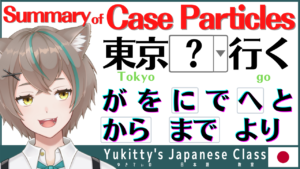

が / を / に / で / へ / と / から / まで / より
Particles are attached to the end of nouns to indicate the relationships between words.
Word order is not important but case particles have important grammatical meanings.
 Yukitty
YukittyIn many cases, the meaning of a sentence does not change even if the word order is unnatural.
However, if the case particles are used incorrectly, the meaning of the sentence will change drastically, so please be careful.




e.g. 犬が歩いています。
A dog is walking. / Dogs are walking.
犬 [noun] dog
歩く [verb] walk
ています [auxiliary verb] be ___ing
The Japanese language does not distinguish singular and plural.
To emphasize the plurality of a word, add “ら”, “たち”, etc. after the word.
e.g. (私は)犬が好きです。
I like dogs. (“私は” is omitted.)
好き [na-adjective] like
私 [noun] I, myself
The “私は” is usually omitted. If not omitted, “私は” becomes an emphatic nuance.
By the way, は is a topic marker.
Nouns of Japanese aren’t distinguished as singular and plural.
These が can be replaced with けど
e.g. (私は)犬は好きだが、猫は好きじゃない。
I like dogs, but I don’t like cats.
猫 [noun] cat
e.g. 探したが、見つからなかった。
I looked for it, but could not find it. (“私は” is omitted.)
探す [verb] look for, search
見つかる [verb] find
e.g. 今日の授業ですが、体調が悪いので欠席します。
Assertion modality だ or です is needed. (normally です is used)
Regarding today’s class, I am not feeling well and will not be attending. (“私は” is omitted.)
今日 [noun] today
授業 [noun] class, lesson, teaching
体調 [noun] (body) condition
悪い [i-adjective] bad
欠席 [noun] absence
e.g. 否定しませんが。
I don’t deny that. (but I think…)
否定する [verb] deny, negate
を has 3 roles below.
e.g. 本を読みます。
I read books. (“私は” is omitted.) / I read a book.
本 [noun] book
読む [verb] read
The Japanese language does not distinguish singular and plural.
e.g. 橋を渡ります。
I cross a bridge. (“私は” is omitted.)
橋 [noun] bridge
渡る [verb] cross
e.g. 学校を出ます。
I leave school. (“私は” is omitted.)
学校 [noun] school
出る [verb] leave, get out
に has 8 roles below.
e.g. 公園にベンチがあります。
There is a bench in the park. / There are benches in the park.
公園 [noun] park
ベンチ [noun] bench
The Japanese language does not distinguish singular and plural.
e.g. 彼には妹がいます。
He has a younger sister. / He has younger sisters.
彼 [noun] he
妹 [noun] younger sister
いる [verb] exist, be (for creatures)
The Japanese language does not distinguish singular and plural.
e.g. 9時に帰ります。
I’ll be back at 9 o’clock. (“私は” is omitted.)
帰る [verb] go back, go home, return
Japanese has only past or non-past tenses.
The present or future tense is determined by context and situation.
e.g. 駅に向かいます。
I head for the station. (“私は” is omitted.)
駅 [noun] train/subway station
向かう [verb] head for, toward, go
e.g. 電車に乗ります。
I will take the train. (“私は” is omitted.)
電車 [noun] train
乗る [verb] get on, mount, take, board, ride
Japanese has only past or non-past tenses.
The present or future tense is determined by context and situation.
e.g. 彼にチョコをあげます。
I will give him chocolate. (“私は” is omitted.)
チョコ/チョコレート [noun] chocolate
あげる [verb] give, raise, up
Japanese has only past or non-past tenses.
The present or future tense is determined by context and situation.
e.g. 上司に言われました。
I was told by my boss. (“私は” and “私の” are omitted.)
上司 [noun] boss
言われる(言う+れる) [verb+auxiliary verb] be told, be said, be called
Same meaning as 上司から言われました。
e.g. 見に行きます。
I am going to see it. (“私は” and “それを” are omitted.)
見る [verb] see, watch, look
行く [verb] go
e.g. 彼はタンジロウに似ています。
He resembles Tanjiro.
似ている(似る+いる) [verb(Te-form)+auxiliary verb] resemble
e.g. 理解に苦しみます。
It is difficult to understand. (I am troubled to understand.)
理解 [noun] understanding
苦しむ [verb] be troubled, suffer
で has 4 roles below.
e.g. 学校で勉強します。
I study at school. (“私は” is omitted.)
学校 [noun] school
勉強 [noun] study
e.g. 鉛筆で書きます。
I write with a pencil. (“私は” is omitted.)
鉛筆 [noun] pencil
書く [verb] write
e.g. その箸は竹でできています。
The chopsticks are made of bamboo.
箸 [noun] chopsticks
竹 [noun] bamboo
できている(できる+いる) [verb(Te-form)+auxiliary verb] be made of
Same meaning as その箸は竹からできています。
e.g. 全力で走ります。
I will run at full power. (“私は” is omitted.)
全力 [noun] full power
走る [verb] run
e.g. 1時間で着きます。
It will arrive in 1 hour.
時間 [noun] hour, time
着く [verb] arrive
e.g. 故障で使えません。
It cannot be used due to a malfunction. (“それは” is omitted.)
故障 [noun] malfunction
使える [verb] can be used
へ has 2 roles below.
e.g. 東京へ行きます。
I’m going to Tokyo. (“私は” is omitted.)
東京 [noun] Tokyo
行く [verb] go
Same meaning as 東京に行きます。
e.g. 彼女へメールします。
I will email her. (“私は” is omitted.)
メールする [verb] email
Same meaning as 彼女にメールします。
The beginning of the letter must be used へ. e.g. “ねずこへ” means “To Nezuko”.
と is often translated to “and” or “with”.
e.g. 犬と歩きます。
I will walk with the dog. (“私は” is omitted.)
e.g. 彼が行こうと言いました。
He said let’s go.
言う [verb] say
e.g. 行こうと思います。
I think I will go. (“私は” is omitted.)
思う [verb] think
“思う”, “判断する”, “決める” etc. quotations are valid for oneself.
e.g. 彼女と同じものを買いました。
I bought the same one as her. (“私は” is omitted.)
同じ [Na-adjective] same
買う [verb] buy
e.g. りんごとバナナを食べます。
I will eat apples and bananas. (“私は” is omitted.)
りんご [noun] apple
バナナ [noun] banana
ゆっくりと、どさっと、がっしりと、さくっと、きらっと、etc. are onomatopeias.
Do not be misled.
から is often translated to “from”.
e.g. アメリカから来ました。
I came from America. (“私は” is omitted.)
アメリカ [noun] America
来る [verb] come
e.g. その店は9時から開いています。
The store is open from 9 o’clock.
店 [noun] store, shop
開く [verb] open
e.g. 彼からカバンをもらいました。
I got this bag from him. (“私は” is omitted.)
カバン [noun] bag
もらう [verb] get, receive, have
Same meaning as 彼にカバンをもらいました。
e.g. チーズは牛乳から作られます。
Cheese is made from milk.
チーズ [noun] cheese
牛乳 [noun] milk
作る [verb] make
e.g. 不注意から怪我をしました。
I was injured due to carelessness. (“私は” is omitted.)
不注意 [noun] carelessness
怪我 [noun] injury
e.g. うるさいから、音楽を止めろ。
It’s too loud,(so) stop the music.
うるさい [i-adjective] noisy
音楽 [noun] music
止める [verb] stop
e.g. 今は幸せだから。
Because I am happy now. (“私は” is omitted.)
今 [noun] now
幸せ [noun, na-adjective] happiness, happy, fortunate
e.g. そこにあるから、使ってね。
It’s there, so use it.
そこ [noun] there
ある [verb] exist, being, there is
使う [verb] use
まで has 1 role below.
まで is often translated to “to” or “up to”.
e.g. 祭りは明日までやっています。
The festival is going on until tomorrow.
祭り [noun] festival
明日 [noun] tomorrow
やる [verb] perform, execute, do, run, hold, play
e.g. 1000円まで使っていいです。
You can use up to 1000 yen. (“あなたは” is omitted.)
使う [verb] use, consume
The “あなたは” is usually omitted. If not omitted, “あなたは” becomes an emphatic nuance.
So it sounds strong and a little rude.
より has 2 roles below.
e.g. タンジロウより。
From Tanjiro. (End of letter)
e.g. りんごはレモンより大きいです。
Apples are bigger than lemons.
りんご [noun] apple
レモン [noun] lemon
大きい [I-adjective] big, large
Put case particles in the underlined part.
自転車____行きます。
I will go by bicycle.
自転車で行きます。
I will go by bicycle.
りんご____買いました。
I bought apples.
りんごを買いました。
I bought apples.
その店は10時____20時____開いています。
The store is open from 10:00 to 20:00.
その店は10時から20時まで開いています。
The store is open from 10:00 to 20:00.
駅____待っています。
I’m waiting at the station.
駅で待っています。
I’m waiting at the station.
彼女____出かけます。
I’m going out with her.
彼女と出かけます。
I’m going out with her.


この記事が気に入ったら
フォローしてね!
Comment
コメント一覧 (1件)
This is a very thorough, organized, and intuitive breakdown. I have started studying Japanese with the goal of being able to read my favourite manga in their original language, and to watch anime and Vtubers. Even with a simple manga, particles are everywhere and I think this is an invaluable reference for getting used to how each of the case particles can be used. Thank you!